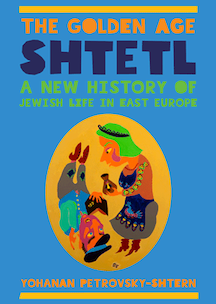By Lewis Fried
Mourning the exterminated Jewish life in Eastern Europe, Avrom Reisen wrote “There was so little then— / Why is there so much left ?” But what is held in the popular, and often scholarly, imagination of Yiddish existence and culture, especially of the shtetl? We have the portrait of the late 19th century dirt-poor shtetl, found for example, in I. L. Peretz’s Impressions of a Journey through the Tomaszow Region in the Year 1890. We are familiar with the anthropological portrait of the shtetl, such as Mark Zborowski and Elizabeth Herzog’s Life Is With People. There is the shtetl “saved,” recalled, and invented (the popularized shtetl of Fiddler on the Roof, the stark photographs of Roman Vishniac, and the mesmerizing images of Chagall’s “village”) accompanying the autobiographies and literary works of those who saw themselves exchanging an impoverished existence for life in America (Mary Antin’s The Promised Land is a good, but smarmy, example ). Is there a different understanding of the shtetl, one that presents an earlier version, and strikingly, a dynamic one? If so, how to separate what we have come to accept as the late 19th century overlaying image of the shtetl dominating our understanding? How do we untangle the shtetl’s meaning from its significance?
The Golden Age Shtetl takes these as foundational questions. By way of answer, it presents the vibrant shtetl during the years from 1790 to 1840. We see the strands of shtetl life in their embroidered pattern: history, economics, culture, and more. Petrovsky-Shtern has much to do, and he does it well. Like a figure in an arabesque carpet, the more you look, the more complex and more engaging the pattern. This is not the Anatevka of Fiddler on the Roof.
What qualified a settlement to be termed a shtetl? In Petrovsky-Shtern’s words, a shtetl had “the elements of the old Polish lease-holding economy, an established trade and a marketplace, and a liquor trade—all run predominantly by Jews” with taxes going into the Russian treasury and, of course, money into the pockets of the authorities.
The shtetl evolved within and out of claims amongst the territorializing and economic fortunes of Russia and Poland. The Polish understanding of it was a “private town,” part of a Polish landholder’s property, in which Jews had been encouraged to dwell, thickening the economy, and dealing in liquor. Given the partition of Poland, Russian administrators saw the shtetl as an “administrative subdivision.” In the 18th century, the shtetl was “Polish Jewish”; a century later, “Russian Jewish,” and for the ordinary Jew, a localized religious community.
For those dwellers who moved to urban and cosmopolitan centers, the shtetl’s appeal was poetic: a response to the Eastern-European Jewish need for a deliberately created past. In other words, we have a cultivated nostalgia for a home that did not correspond to its realities. Stripped of its empirical existence, its “imaginary residue” is then sugarcoated. How to restore the shtetl to what it was?
Its “golden age” is the period Petrovsky-Shtern brings to the forefront. In his illuminating reading of these years, we find the shtetl’s prosperity. Fairs, a thriving liquor business, a marketplace that received goods and ideas from elsewhere (and sometimes far elsewhere), an often forgotten publishing business (albeit most of its works devoted to religious tracts and books), a developed porousness made possible by bribing authorities, and a qualified ability to withstand anti-semitism—these aspects reveal a more sustainable life than that presented by the shtetl’s later image.
The Golden Age Shtetl rests on a treasure of data; the book easily shifts from Petrovsky-Shtern’s dedicated archival searchings to case examples. We meet through court and police proceedings, cases involving contraband, and violence; through studies of trade we encounter how homes were decorated and what clothes people wore; from a study of the liquor business, we understand how local and national politics influenced dealer and buyer. From the book’s delving into the publishing industry, we realize not only how and what books informed a reader, a congregation, and a rabbi, but also why Russian censors, pushing hard against the spread of “mystical” works, understood them as obstacles to modernity and government authority.
The shtetl of this period did not, and could not, withstand the modernization of Russia. The shtetl entered an “iron age” of anti-Semitic brutality and wars. Yet, the golden age shtetl will shine for readers of this book.
Lewis Fried (ΦBK, Queen’s College, CUNY, 1964) is Professor of English Emeritus at Kent State University and a resident member of the Nu of Ohio chapter of Phi Beta Kappa.




